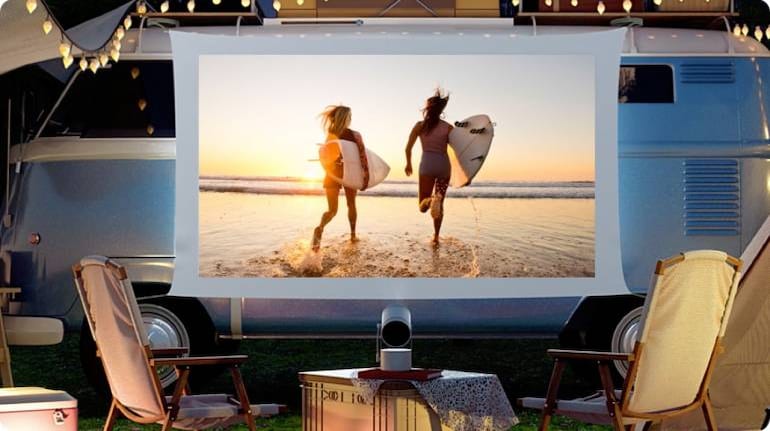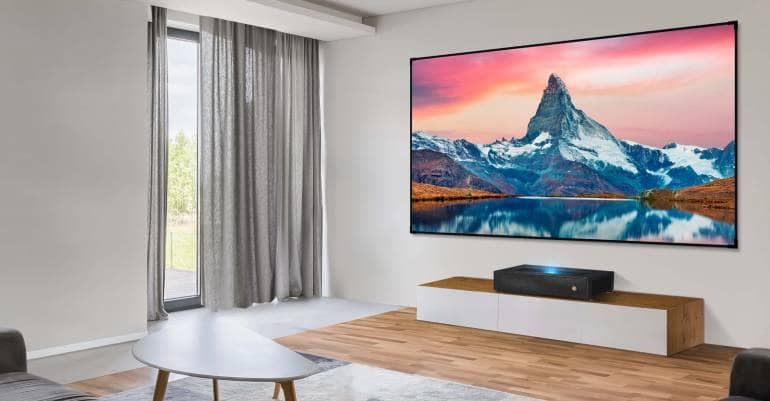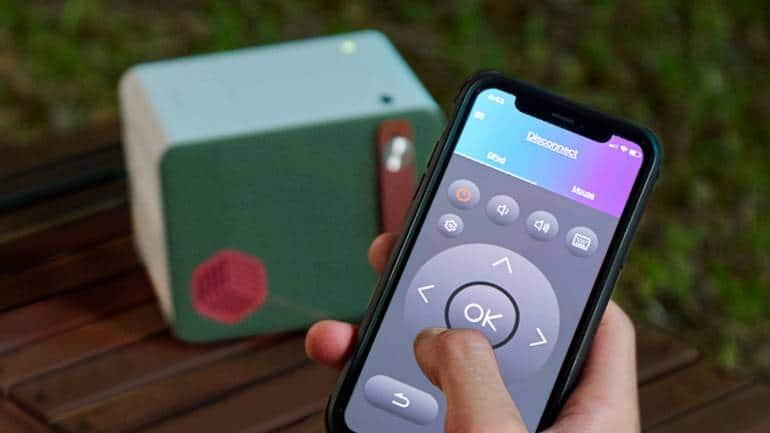



Jeffrey Liang (president — APAC, BenQ) is bullish about India’s potential as a projector market. India is already the third-largest market for the company (aside from China and the US). He is not alone. There were multiple gadget trends that emerged during the pandemic. Tablets made a comeback of sorts driven by the WFH and study from home lifestyles. Wellness became a buzzword in the wearable space and large screen entertainment shifted from the cinemas to living rooms. Some of these trends have survived the pandemic and are here to stay.
Theatres are back in the mix but… BenQ home projector.
BenQ home projector.Bollywood blockbusters like Jawan, Gadar 2 and films like Leofronted by south Indian super star Vijay have all pushed their films comfortably over the Rs 500 crore line. But the massive success of these films has overshadowed dozens of films that have been non-starters at the box office. India’s big superstars are our own equivalent of an Avengers franchise. These are no longer movies but events with massive FOMO attached to them. The pressure (driven heavily by social media) to be seen at the theatre and not necessarily the content is driving the success of these films that do a majority of their business in the opening week. There’s a discernible shift in viewer preferences — most of us can’t watch a 150-minute film at home or in the theatre but might binge watch an entire OTT series in one weekend.
Changing customer perceptionsMost projector manufacturers depended heavily on the commercial and educational segments in a pre-pandemic world. They still do but the market share of consumer projectors has begun to rise post the pandemic. Longevity was one of the barriers in India. Many customers were apprehensive about the durability of projectors — especially the lamp that powers the projectors. This was at a time when TVs were considered a 5-10 year investment in India. The other issue was connectivity and set-up. A whole range of projectors offers customers a choice of options that are tailored for their particular needs. We can broadly break this down into to three customer categories — budget projectors (that are conventional ‘long throw’ projectors that we see on board rooms), portable projectors (that typically offer 60 to 180 minutes of battery life) that are lightweight and flexible as well as the premium short throw projectors where you can create a 100-inch projection with a few inches distance.
 BenQ projector.
BenQ projector.For instance, BenQ’s all new BenQ V5000i that debuted in October 2023, lands in the premium space and needs just a few inches for a massive projection and offers a 4K Ultra HD resolution. Samsung didn’t wait too long to launch Freestyle, a show stopper at the CES gadget show in Las Vegas. It’s a projector, smart speaker and ambient lighting device all rolled into one. It’s lightweight (830 gm) and comes with a versatile cradle that allows rotation of up to 180 degrees.
The consumer projector segment is booming BenQ projector.
BenQ projector.According to the Business Research Company the global projectors market is poised to grow from USD 10.81 billion to 11.49 billion in 2023, at a CAGR of 6.3%. It’s the India numbers that reveal the shifting consumer preferences. According to Rajeev Singhal, managing director — BenQ India, the size of the Indian market is set to expand from Rs 1,000 crore in 2022 to Rs 1,200 crore by 2023. According to Singhal, the B2C market in 2019 was 12 per cent (in terms of units) and 20 per cent in revenue markets. That’s likely to completely change by 2024 when BenQ expects the overall share of consumer projectors to hit 50 per cent in revenue terms and 35 per cent in terms of units sold. The average ticket size is higher in the consumer segment because of the presence of high-end, 4K projectors while the B2B segment also includes educational institutions that reduce the yields.
It's all coming together ViewSonic M1 Pro projector.
ViewSonic M1 Pro projector.It’s not just the desire for large screen entertainment. We’ve seen a slew of factors that have fuelled the interest for home projectors. Android TVs have done away with the need for cables as most of us leverage improved internet speeds to lean on App-based and OTT content. Most projector brands are doing away with their custom UI and opting for the familiarity of Android TV. Jeffrey Liang believes brands should focus on the bedroom or the den as the entry point into Indian homes. While a large-sized TV might still occupy pride of place in your living room, smaller portable projectors can fit in seamlessly into smaller living areas like bedrooms or dens where most Indian homes have a second screen. We’ve seen products like the Freestyle, BenQ’s GS50 and ViewSonic’s M1Pro make a pitch for this space with lightweight, portable projectors that all cost under Rs 1 lakh.
Singhal also claims that these portable projectors are less burdensome compared to large TVs for Gen Z audiences who tend to move homes and cities more frequently than older audiences. Could we see home projectors replacing TVs or are we likely to see a home entertainment landscape that has room for both types of viewing experiences? We’ll discover soon enough.

Discover the latest Business News, Sensex, and Nifty updates. Obtain Personal Finance insights, tax queries, and expert opinions on Moneycontrol or download the Moneycontrol App to stay updated!
Find the best of Al News in one place, specially curated for you every weekend.
Stay on top of the latest tech trends and biggest startup news.